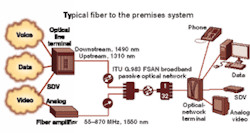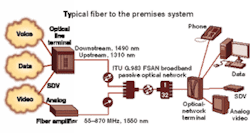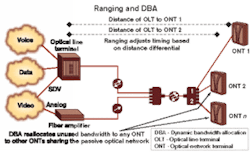Interoperability aids FTTP deployments
Since the inception of fiber to the premises (FTTP) technology, vendors have offered end-to-end systems that stretch from the central office (optical line terminals—OLTs) to subscriber terminals (optical-network terminals—ONTs). While many of these systems are based on ITU G.983.x (ATM passive-optical-network—APON) standards, the equipment itself is proprietary to each vendor. As a result, a carrier buying one vendor's OLT must also buy that vendor's ONTs. But as RBOCs and other large carriers plan significant rollouts of PON systems, they are demanding ONT interoperability so they can create multiple sources of supply and have the flexibility to adopt specific ONTs for specific applications.
The telecommunications industry has long recognized the "faster, better, cheaper" promise of competition. Open, standards-based, interoperable systems create such competition among equipment vendors, which creates lower prices and better products that come to market more quickly. Nevertheless, suppliers and carriers often resist interoperability.
Suppliers want to differentiate themselves from their competitors, and they want to avoid the commoditization of their technology. Avoiding or delaying interoperability and competition may seem like a way to ensure a more profitable product, but highly differentiated products rarely succeed in telecom. The network is too broad to allow vendor-specific implementations, no matter how interesting the differential features. Successful telecom products are always commodities (to some extent) that comply with standards and provide added value.
Carriers sometimes defer the benefits of interoperability and offer exclusive single-vendor contracts as an inducement for concessions on initial pricing, features, and deployment assistance. Carriers also know that testing and approving a single-vendor product is less time-consuming and less expensive than testing products from multiple vendors—and the greater the product's impact on the network, the truer this statement is. Often, their plan is to qualify a single-vendor system, then open the network to other vendors after the initial deployment. Carriers recognize that interoperability is important, but they don't insist on it from the start to minimize short-term costs.
But the history of telecom-network deployment is clear: open, interoperable systems scale to mass deployment faster and at lower cost than single-vendor systems. The sooner systems become interoperable, the better. Delaying interoperability slows the deployment process, no matter what the reason.
In FTTP systems, the OLT and ONT are very different products that require different core competencies. Figure 1 shows a typical FTTP system with the OLT in the central office or remote cabinet and the ONT at the customer site. Also shown is the analog video overlay option that some customers are using.The OLT is an access platform. The challenge in building an open, interoperable OLT is the hardware and software integration. The OLT must incorporate all of the technology of a next-generation digital loop carrier (NGDLC) and more. It must integrate a voice gateway for telephony service, which must include TDM interfaces (TR-08 and GR-303) and increasingly softswitch interfaces such as H.248. The OLT must also incorporate switching, whether a TSI, ATM, or IP switch fabric. It must meet NEBS 3 requirements. Finally, it must be managed via an element management system and northbound interfaces to the carrier's operational support system.
The challenge with the ONT, on the other hand, is much more mechanical. The box that houses the ONT must be attractive and rugged enough to hang on the outside wall of a home. The ONT must also be easy to install, since installation time at the customer's home is one of the major cost factors involved with FTTP deployment. Innovative powering solutions are also important value-added features. Finally, due to the volume of ONTs deployed, product cost is a major issue.
Given the difference between OLT and ONT requirements, each type of product must be designed by different companies or at least by different groups within a large company. Each type of product requires different skills to design and manufacture, and each one has different business success models. ONT vendors, in particular, are now offering a number of options that differ among the number of lines supported, services offered, powering systems, and installation procedures. The differences between these product types make interoperability all that much more important.
The ITU G.983 standard clearly calls for ONT interoperability. Carriers have asked for standards-compliant FTTP systems as well as ONT interoperability. But asking isn't getting, and most of the FTTP trials and rollouts to date have been of single-vendor systems. It is less costly and time-consuming to initially deploy a single-vendor system, but it can be difficult to open up such systems and scale them once they are in place. Early implementation of interoperability will provide a valuable headstart in the race to scale FTTP networks to mass deployment.
Interoperable ONTs have been announced as early as last October, and interoperable FTTP systems have been delivered to customers. There were several lessons learned in this effort that bode well for making the use of interoperable ONTs widespread.
The first lesson is that FTTP interoperability is easier than ADSL interoperability, which is the most recent comparable interoperability experience in the telecom industry. In ADSL, the physical layer (PHY) was the most difficult part of achieving interoperability. The challenge was to wring the most performance out of the twisted-pair plant. In addition, the ADSL Discrete Multi-Tone (DMT) specification was complex and included multiple options.
In FTTP systems, the PHY (the optics) is much less challenging. The implementation is digital, not analog. In addition, there are fewer variable options, and the Full Services Access Network (FSAN) group, which worked with the International Telecommunication Union (ITU) to issue G.983, also issued an implementer's guide that clarified several items. Some companies that have pursued interoperability discovered that PHY interoperability was achieved early in the integration process, even when the OLT and ONT products were developed independently.
Two more challenging areas for FTTP interoperability are the ranging process and dynamic bandwidth allocation (DBA). The ranging process adjusts the timing for each ONT to compensate for the differential distance from the OLT to ONT. DBA ensures that unused bandwidth on one PON leg is allocated to other PON legs that need the bandwidth, thereby ensuring efficient use of bandwidth on the PON. Both ranging and DBA require communication between the OLT and ONT based on an interoperable message set. Figure 2 shows the need for ONT ranging and the effect of DBA. Fortunately, neither of these challenges has proved particularly difficult to overcome.Another challenge for FTTP interoperability is the transport layer. The FTTP transport layer is more complex than the DSL transport layer because it is carrying multiple services (e.g., POTS, data, and T1 services). In ATM-based PONs (APON and broadband PON), POTS service is adapted via AAL2 according to the BLES standard. Data is adapted using AAL5, and T1 is adapted using AAL1. ADSL, on the other hand, carries all services in one channel and often does not implement the interleaved/non-interleaved bearer channels that could be used to separate voice and data. IP is used as the convergence layer for ADSL and different applications are transported transparently to the network. Different service adaptation strategies could derail FTTP interoperability.
Another area of complexity is in traffic management options. The G.983 standard offers priority queuing or virtual path crossconnect, so OLT and ONT developers must agree on which option to use in an interoperable system. This challenge requires coordination between OLT and ONT developers, but once the implementation plan is set, interoperability should be straightforward.
As last year's announcements indicate, these and other challenges can be successfully overcome to deliver OLT-to-ONT interoperability. The early success of this effort should reassure carriers interested in FTTP that interoperability is available from the start and need not be delayed.
Carriers and their FTTP equipment suppliers have started to move forward with initial FTTP deployments. They have proven that it is possible to meet both the technical and business requirements for successful FTTP services.
The challenge now is to scale these initial deployments from a few thousand homes to hundreds of thousands and then millions of homes. Success with broad FTTP deployment will put North America back into the global leadership position for broadband access. Competition via open, interoperable systems is the only way to ensure that FTTP scales to mass deployment quickly and cost-effectively. Interoperability is critical to the success of fiber to the premises.
Don McCullough is director of product marketing at Entrisphere (Santa Clara, CA). He can be reached via the company's Website, www.entrisphere.com.


